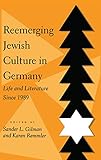Reemerging Jewish Culture in Germany : Life and Literature Since 1989 / Sander L. Gilman, Karen Remmler.
Material type: TextPublisher: New York, NY : New York University Press, [2020]Copyright date: ©1994Description: 1 online resourceContent type:
TextPublisher: New York, NY : New York University Press, [2020]Copyright date: ©1994Description: 1 online resourceContent type: - 9780814730621
- 9780814733462
- 305.8924043
- DS135.G332
- online - DeGruyter
| Item type | Current library | Call number | URL | Status | Notes | Barcode | |
|---|---|---|---|---|---|---|---|
 eBook
eBook
|
Biblioteca "Angelicum" Pont. Univ. S.Tommaso d'Aquino Nuvola online | online - DeGruyter (Browse shelf(Opens below)) | Online access | Not for loan (Accesso limitato) | Accesso per gli utenti autorizzati / Access for authorized users | (dgr)9780814733462 |
Frontmatter -- Contents -- Acknowledgments -- Contributors -- Introduction -- Part one. Jewish life in Germany -- 1. The contemporary German fascination for things Jewish: toward a minor Jewish culture -- 2. A reemergence of German Jewry? -- 3. Becoming strangers: Jews in Germany's five new provinces -- Part two. Contemporary issues: politics, religion, and immigration -- 4. What is "religion" among Jews in contemporary Germany? -- 5. "What could be more fruitful, more healing, more purifying?" representations of Jews in the German media after 1989 -- 6. The "ins" and "outs" of the new Germany: Jews, foreigners, asylum seekers¹ -- 7. The Persian gulf war and the Germans’ “Jewish questions”: transformations on the left -- Part three. Literature and sexuality -- 8. What keeps the Jews in Germany quiet? -- 9. En-gendering bodies of memory: tracing the genealogy of identity in the work of Esther Dischereit, Barbara Honigmann, and Irene Dische -- 10. Male sexuality and contemporary Jewish literature in German: the damaged body as the image of the damaged soul -- Part four. Concluding voices -- 11. In defense of ambiguity -- 12. No exit from this Jewry -- Index
restricted access online access with authorization star
http://purl.org/coar/access_right/c_16ec
How can there by a Jewish culture in today's Germany? Since the fall of the Wall, there has been a substantial increase in the visibility of Jews in German culture, not only an increase in the number of Jews living there, but, more importantly, an explosion of cultural activity. Jews are writing and making films about the central question of Jewish life after the Shoah. Given the xenophobia that has marked Germany since reunification, the appearance of a new Jewish is both surprising and normalizing. Even more striking than the reappearance of Jewish culture in England after the expulsion and massacres of the Middle Ages, the presence of a new generation of Jewish writers in Germany is a sign of the complexity and tenacity of modern Jewish life in the Diaspora. Edited by Sander L. Gilman and Karen Remmler and featuring works by many of the most noted specialists on the subject, including Susan Niemann, Y. Michael Bodemann, Marion Kaplan, Katharina Ochse, Robin Ostow, Rafael Seligmann, Jack Zipes, Jeffrey Peck, Kizer Walker, and Esther Dischereit, this volume explores the questions and doubts surrounding the revitalization of Jewish life in Germany. The writers cover such diverse topics as the social and institutional role that Jews now play, the role of religion in daily life, and gender and culture in post-Wall Jewish writing.
Mode of access: Internet via World Wide Web.
In English.
Description based on online resource; title from PDF title page (publisher's Web site, viewed 06. Mrz 2024)


